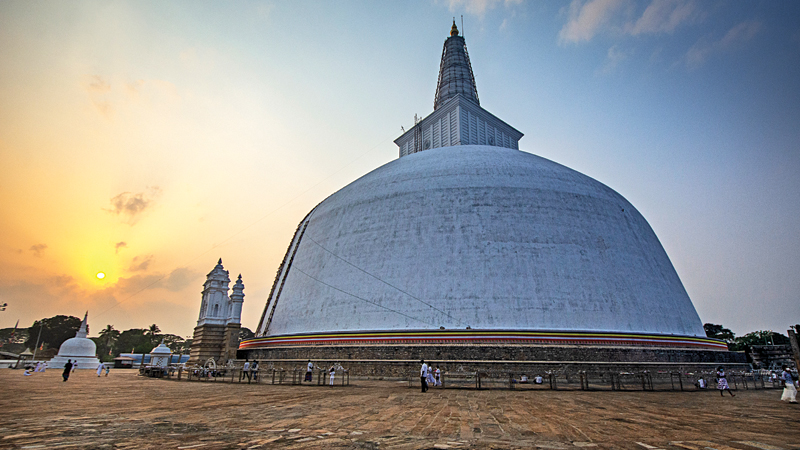 Following the visit to Dambulla, Sigiriya and Mihintale our final destination in our bucket list was Anuradhapura. As for me visiting Anuradhapura was a regular family trip from my childhood days. The early trip was usually by train. We got into the train from the Fort Station and reached Anuradhapura in the evening. We stayed at a rest house (Visramasaala) and travelled around in a hired car. There were no taxis or three-wheelers those days but private cars were available for hire. We usually hired a vehicle to move around the ‘Atamasthana’ on an agreed fare.
Following the visit to Dambulla, Sigiriya and Mihintale our final destination in our bucket list was Anuradhapura. As for me visiting Anuradhapura was a regular family trip from my childhood days. The early trip was usually by train. We got into the train from the Fort Station and reached Anuradhapura in the evening. We stayed at a rest house (Visramasaala) and travelled around in a hired car. There were no taxis or three-wheelers those days but private cars were available for hire. We usually hired a vehicle to move around the ‘Atamasthana’ on an agreed fare.
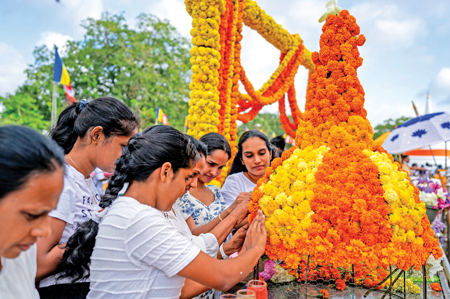
Beautiful flower offerings at the Ruwanveliseya dagaba
This was in the latter part of the 1970’s and as a child I was amazed by the huge dagabas in the holy city. While Ruwanveliseya was the most attractive having been fully restored, the other dagabas were just mounds of earth. Yet, devotees did not miss the eight places of worship and covered the ‘Atamasthana’ every time they visited Anuradhapura.
A few decades ago, transport facilities were nowhere near what it is today, ‘Vandana nades’ used the railway for their pilgrimages. The biggest attraction was the dagabas. Van, bus and private car rides are popular today.
Anuradhapura is slowly but surely getting back to its glory days. The Abhayagiri dagaba is the latest to be restored and has been restored to its former status. Restoration work on the Jetavanaramaya dagaba and the Mirissawetiya has also been completed. All three were weather-worn stupas not so long ago. The Central Cultural Fund has fully completed its task in the historic city.
Grandeur
The grandeur that was Anuradhapura, the first capital of Sri Lanka has been vividly described by foreign visitors and experts.
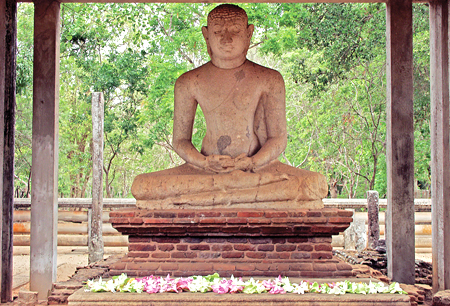
The magnificent Samadhi Buddha statue
Well-known author on archaeological subjects, Leonard Eric Cottrell wrote that many of the old monuments in Anuradhapura were begun contemporary with the conquests of Alexander the Great and his successors and continued throughout the period of the Roman Empire.
He states, “Yet even the greatest architectural achievements of the Roman emperors cannot compare with the finest works of the Sinhala kings who were their contemporaries.
The area of Anuradhapura for instance was 250 square miles; the palaces of monarchs such as Dutthagamani as described by the ancient Sinhalese writers would have made Diocletian’s palace seem a poor comparison; their great dagabas, artificial mounts of masonry, supporting shrines and reliquaries were sometimes over 300 feet in height and could be compared with the pyramids of Egypt.
Their hydraulic engineering has no parallel save in the 19th and 20th centuries; for example the tank at Minneriya constructed in the 3rd Century by King Mahasen had a circumference of twenty miles and the masonry and earthwork dams which were made to divert the waters which fills it extend to eighty miles; the average height being eighty feet.”
The magnificent Samadhi statue in the northern part of the city of Anuradhapura depicting the Buddha in the serene Samadhi pose or in deep meditation could be viewed. It is said that Indian statesman, Pandit Jawaharlal Nehru found solace and strength just viewing a photograph of this statue while being imprisoned by the British. Nehru had said, “The strong, calm features of the Buddha’s statue soothed me and gave me strength and helped me overcome many a period of depression.”
The most popular site in Anuradhapura, the Ruwanveliseya (Maha Thupa) constructed under the orders of King Dutthagamani Abhaya (2nd Century BCE.) is reputed to enshrine the largest number of body relics of the Buddha. With a height of 300 ft. and a base circumference of 942ft. the Maha Thupa was the most stupendous of all thupas in the Buddhist world. Its restoration was completed in 1940.
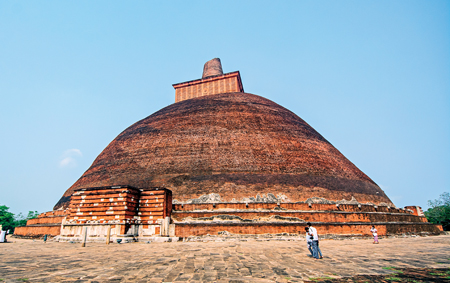
The Jetavanarama dagaba
The Abhayagiri monastery dates back to the time of King Vatagamini Abhaya (Valagamba) during his second reign (89-77 BCE). The Mahavamsa has the story of how the king had to flee the capital after ascending the throne in 109 BCE when he was threatened by the invading Tamils.
As he abandoned the throne and was fleeing a ‘nigantha’ (Jain monk) named Giri who was in his hermitage is said to have shouted insultingly, “The great black Sinhalese lion is running away.” The king went into hiding in the hills. Having built up his troops, after 14 years he marched to Anuradhapura in 89 BCE and defeated the ruling king Bhatiya and got back the throne.
He remembered the insult and when he returned victorious, he razed the hermitage to the ground and in its place built a dagaba and 12 buildings as residence for bhikkhus. He named the monastery ‘Abhayagiri’ by the combination of his name Abhaya with the name of the nigantha, Giri and bestowed it to Mahatissa Thera as a token of gratitude during his period of adversity. In the years that followed, the monastery developed as a well-recognised seat of learning.
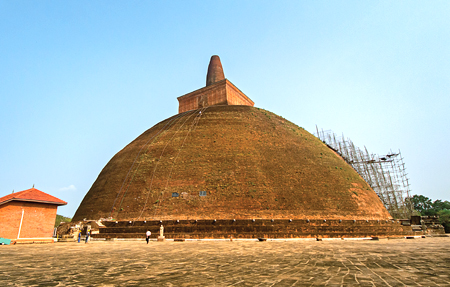
Impressive Abhayagiri dagaba
The Chinese bhikkhu, Faa-Hsien who came on a visit to Sri Lanka in the fifth Century states that he noticed around 5,000 bhikkhus residing in the monastery compared to 3,000 bhikkhus who resided at the Mahavihara, the monastery established earlier.
The place where the Abayagiriya dagaba was constructed has been accepted as one of the 16 places visited by the Buddha. Thus, it has been built over a foot impression of the Buddha.
The original height of the Abayagiriya dagaba was 113 metres but over time it has reduced to 75 metres. It is only second in height to the Jetavanaramaya dagaba which is 120 metres and incidentally said to be the world’s third tallest edifice following the two tallest pyramids in Egypt.
The Jetavanaramaya dagaba is the tallest Buddhist stupa in the world and is also the world’s tallest building built of brick. Once the ruins in Anuradhapura were restored, the city became the most visited place of worship by Buddhist pilgrims. In addition to the devotion of pilgrims, easy accessibility from any part of the country has made Anuradhapura a popular city visited by many.





